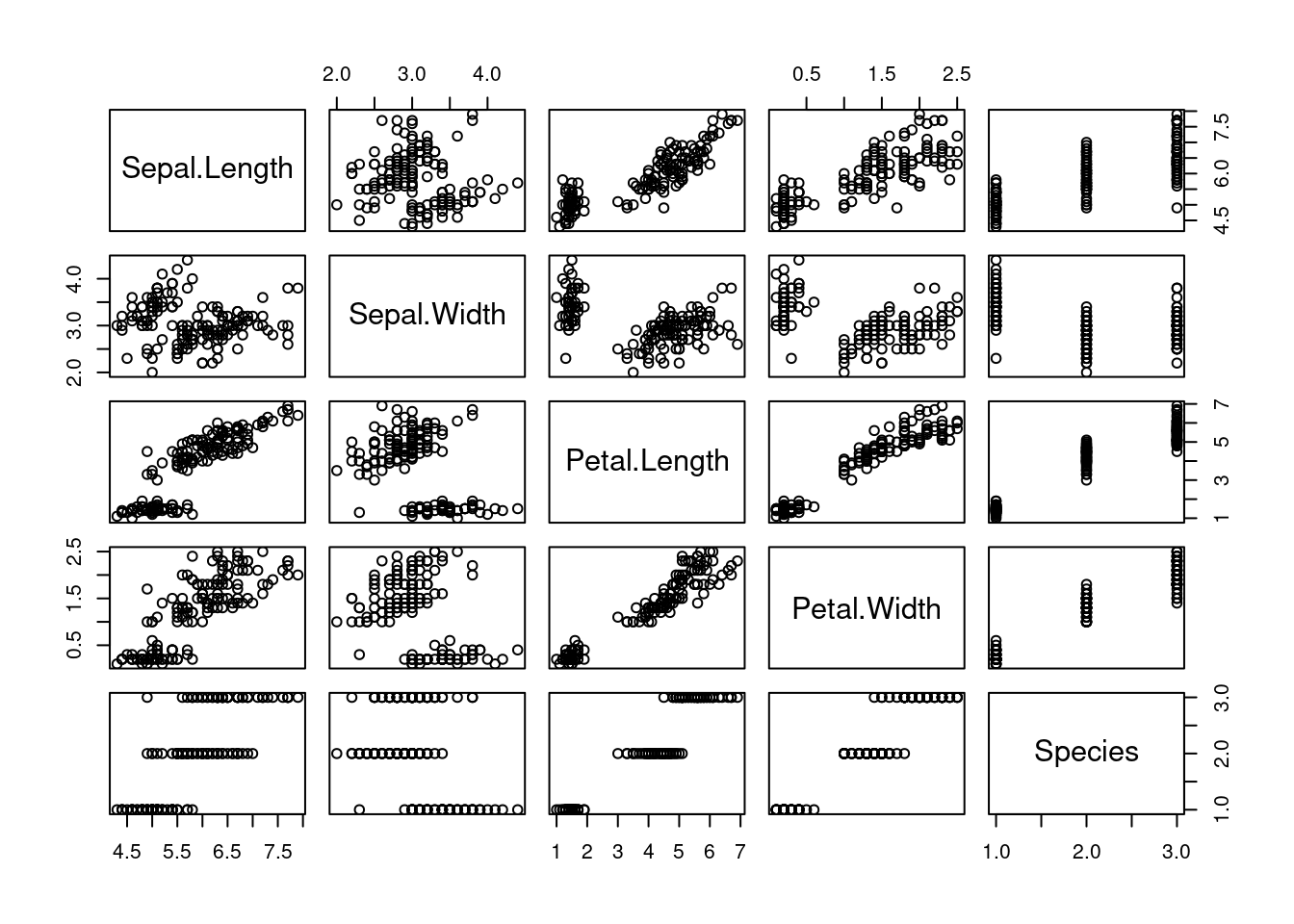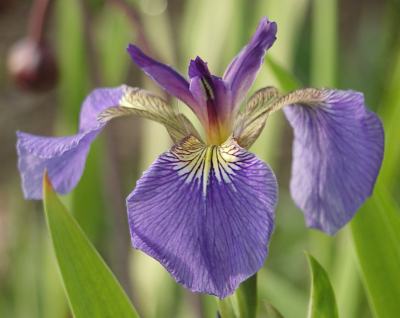pairs(iris)
Documenting process for blogging with Pelican and R Markdown with a focus on figures.
Mark Isken
April 19, 2018
UPDATE (2023) - This blog is now Quarto based
This blog is powered by Pelican and many of the posts are written using reStructuredText. Often, these posts take the form of tutorials developed using Jupyter notebooks or R Markdown documents. My less than super frequent posting schedule results in me constantly refiguring out exactly how to include the Jupyter notebook or R Markdown content. Dealing with things like included images or plots generated from ggplot2 or matplotlib is often troublesome. It would really make sense if I just carefully documented the workflow for doing these things and publish it as its own blog post. So, here it is. Hopefully this will save me (and others) time and frustration in the future.
I will use the famous Iris dataset (of course).
I had done various ad-hoc things to do R related blog posts using R Markdown. Then I found an approach described in Michael Toth’s data science blog. The basic approach is to use run an R script from the command line using the Rscript program that uses knitr commands to:
It’s those last two steps that were causing me grief. Images and plots weren’t showing up on the local devserver. I’d hack fix it by publishing to my host and then manually uploading image files to the “right place” based on the URL’s in the generated HTML. I’m sure it’s something dumb I’m doing but time to get it sorted out, fixed and documented.
Here’s the R script that I borrowed (from Toth’s post):
#!/usr/bin/Rscript --vanilla
# compiles all .Rmd files in _R directory into .md files in blog directory,
# if the input file is older than the output file.
# run ./knitpages.R to update all knitr files that need to be updated.
# run this script from your base content directory
library(knitr)
KnitPost <- function(input, outfile, figsfolder, cachefolder, base.url="/") {
opts_knit$set(base.url = base.url)
fig.path <- paste0(figsfolder, sub(".Rmd$", "", basename(input)), "/")
cache.path <- file.path(cachefolder, sub(".Rmd$", "", basename(input)), "/")
opts_chunk$set(fig.path = fig.path)
opts_chunk$set(cache.path = cache.path)
opts_chunk$set(fig.cap = "center")
render_markdown()
knit(input, outfile, envir = parent.frame())
}
knit_folder <- function(infolder, outfolder, figsfolder, cachefolder, force = F) {
for (infile in list.files(infolder, pattern = "*.Rmd", full.names = TRUE)) {
print(infile)
outfile = paste0(outfolder, "/", sub(".Rmd$", ".md", basename(infile)))
print(outfile)
# knit only if the input file is the last one modified
if (!file.exists(outfile) | file.info(infile)$mtime > file.info(outfile)$mtime) {
KnitPost(infile, outfile, figsfolder, cachefolder)
}
}
}
#knit_folder("_R", "blog", "figures/", "_caches")
knit_folder("_R", "content", "images/", "cache")The only changes I made were in that last line and just made to match my blogging folder structure. The subfolders inside the images/ folder were created by the knitpages.R script above.
.
├── cache
├── content
│ ├── extra
│ ├── images
│ ├── literalhtml
│ └── pages
├── images
│ ├── obsim_caret_part1
│ ├── obsim_caret_part2
│ ├── obsim_caret_part3
│ ├── otbirders_1_ebirdapi_python_1
│ ├── post_metamods_pp_1
│ └── simmer-getting-started
├── output
├── __pycache__
└── _R
├── data
├── images
└── images
36 directoriesUm, as I write this I realize one source of my problems. The only images/ folder I should have should be inside the content/ folder. Furthermore, it’s the base.url parameter in the R script, which is defaulted to ‘/’, that is causing the script to generate subfolders inside images/ instead of content/images/. Perhaps Toth’s Pelican powered site is structured slightly differently than mine in terms of where the images/ folder resides. So, I changed the R script to default the base.url to ./. That fixed one whole set of issues of the R generated plots not having correct paths generated in the markdown and html files. Now, folder structure looks like this.
├── cache
├── content
│ ├── extra
│ ├── images
│ │ ├── obsim_caret_part1
│ │ ├── obsim_caret_part2
│ │ ├── obsim_caret_part3
│ │ ├── otbirders_1_ebirdapi_python_1
│ │ ├── post_metamods_pp_1
│ │ └── simmer-getting-started
│ ├── literalhtml
│ └── pages
├── output
├── __pycache__
└── _R
├── data
└── imagesLet’s take a look at the famous iris dataset.
What do those irises look like? So, should I use the main blog’s images/ folder or should I use a subfolder of the folder containing this Rmd file? Up till now, I’ve been doing the latter. I should do both. This ensures the published site will have correct links to images and will allow me to use knitr inside R Studio while writing the post to check out how things will look.
Ok, so this is getting a little self-referential. But, after the above chunk, I went to my blog’s main folder and ran
$ ./knitpages.RThen I went and looked at the blogging_pelican_rmd.md file that was generated and placed into the content/ folder. The Markdown generated to display the pairs plot is:
and, for the iris image:
Now generate the site locally:
$ make devserverand viewed the post in the local server and, yep, both the generated pairs plot and the jpg Iris image appear.
Now generate the site to publish remotely:
$ make publishYep, both images appear.
For R Markdown blogging with Pelican, I need to do the following:
content/images folder as well as the _R/images folder (the latter not necessary but a nicety if knitting from R Studio for testing)."./" for base.urlimages/ for output folder for images.Here’s working version of knitpages.R.
#!/usr/bin/Rscript --vanilla
# compiles all .Rmd files in _R directory into .md files in blog directory,
# if the input file is older than the output file.
# run ./knitpages.R to update all knitr files that need to be updated.
# run this script from your base content directory
library(knitr)
KnitPost <- function(input, outfile, figsfolder, cachefolder, base.url="/") {
opts_knit$set(base.url = base.url)
fig.path <- paste0(figsfolder, sub(".Rmd$", "", basename(input)), "/")
cache.path <- file.path(cachefolder, sub(".Rmd$", "", basename(input)), "/")
opts_chunk$set(fig.path = fig.path)
opts_chunk$set(cache.path = cache.path)
opts_chunk$set(fig.cap = "center")
render_markdown()
knit(input, outfile, envir = parent.frame())
}
knit_folder <- function(infolder, outfolder, figsfolder, cachefolder, force = F) {
for (infile in list.files(infolder, pattern = "*.Rmd", full.names = TRUE)) {
print(infile)
outfile = paste0(outfolder, "/", sub(".Rmd$", ".md", basename(infile)))
print(outfile)
# knit only if the input file is the last one modified
if (!file.exists(outfile) | file.info(infile)$mtime > file.info(outfile)$mtime) {
KnitPost(infile, outfile, figsfolder, cachefolder, "./")
}
}
}
#knit_folder("_R", "blog", "figures/", "_caches")
knit_folder("_R", "content", "images/", "cache")